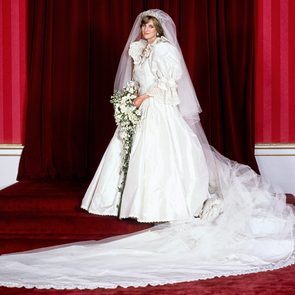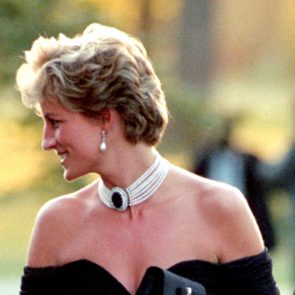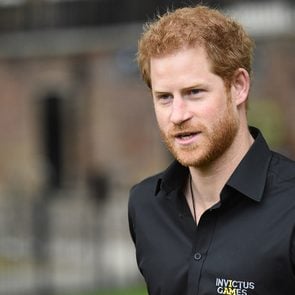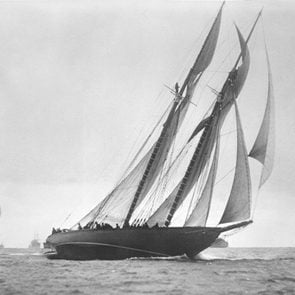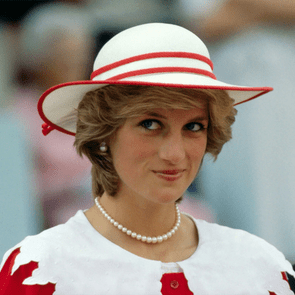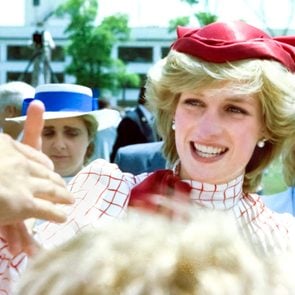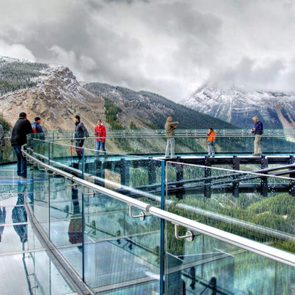It’s no secret Prince Charles and Princess Diana did not have a happy marriage. In fact, the union barely had a fighting chance from the time Charles proposed. The couple, who barely knew each other, was up against the pressure of being in the public eye and a 12-year age difference. But most importantly, their marriage was marred by the fact that Charles was still in love with his former flame, Camilla Parker Bowles. (Here’s why Charles and Camilla didn’t marry each other in the first place.)
According to Diana: Her True Story by Andrew Morton, the young princess had strong suspicions of her husband’s relationship with Camilla from the time they were engaged and she bought her former lover a piece of jewelry customized with an inside joke. However, those close to the princess denied the affair, causing her to question her own sanity. The Queen Mother even told her friends Diana was a “silly girl” for imagining such things. Despite this, Diana pressed on with her belief and even confronted Camilla about the affair.
However, Diana’s suspicions about Charles’s affair were indeed correct. And in fact, some of the people denying her claims were the very people trying to hide the illicit relationship from her. According to a new foreword in Morton’s book, Charles asked his staff’s assistance to cover up his affair with Camilla. Charles’s bodyguard was forced to accompany the prince on illicit nighttime visits to see Camilla, while his chef and butler were instructed to cook dinner even though they knew Charles would be out with his lover. Charles’s valet was instructed to mark up the TV listings guide to make it look like the prince had spent the night at home watching television. When Charles broke his arm in a polo accident, his staff was responsible for listening to police radios to track Diana’s journey to the hospital, so they could get Camilla out of Charles’s room before the princess arrived.
Charles’s staff were sickened by the deception, according to Morton, and predicted the imploding of the marriage. In 1994, the secret came out when Charles admitted to the affair publicly, two years after he and Diana had officially separated. The couple finally divorced in 1996 and Charles went on to marry Camilla in 2005.
Check out 10 royal memoirs that shocked the world.
Kim Fry, a 40-something teacher in Halifax, tries her best to live by her values. As a lifelong grassroots activist, Fry’s commitment to progressive causes informs the way she approaches her family, her job as an educator and her relationships. She’s aware that her dedication to lefty politics may seem over-the-top to some people, and she’s okay with it. Those in her carefully chosen network largely understand— and share—her principles.
So Fry was alarmed when, well into the Covid-19 pandemic, people in her circle started posting conspiracy theories and vaccine myths on social media.“It was scary,”she says,“because these are people I felt politically aligned with—in some cases for more than two decades.” Fry shared resources and tried to engage in healthy debate. But with one longtime friend, she says, she found herself fighting a losing battle.
Fry was gobsmacked to see her pal voice support for the “Freedom Convoy” in Ottawa, while also seeming to dismiss the presence of hateful and xenophobic messaging. In numerous private conversations, her friend held firm. “It was so hard,” Fry says, sadly. “I really thought we could come to a place of understanding.”
According to a 2022 report by the Abacus research group, nearly a quarter of all Canadians had relationships that were negatively affected by contradictory views over Covid-19. Even in normal times, we gain and lose pals all the time. One 2009 study found that adults replace 50 per cent of their social circle every seven years. But how do you decide when a friendship has run its course? And, once you do, what’s the best way forward?
Be Clear and Accountable
Danielle Bayard Jackson is a certified women’s coach who specializes in friendship and communication. In summer 2020, she noticed an uptick in the number of people who came to her seeking guidance about how to break up with a friend. “People were saying, ‘I see my friends differently,’” she says. “Cultural and global events during the pandemic led many of us to reassess who we want in our circle.”
Beyond conflicts over core values, there are many reasons why people stop being friends: maybe one of you has hit a milestone (parenthood, say) and the other can’t relate; maybe you and your joined-at-the-hip dorm-mate drifted apart after graduating from university; maybe your work bestie got a new job and the two of you no longer bond over office drama. No matter the context, clarity is key, says Bayard Jackson: “First, ask yourself why you’re considering terminating the friendship. Next: have you verbalized that to the other person?”
Even when you’re parting with a pal who suddenly seems to have a different worldview, let them know what’s going on. Stacy Thomas is a psychologist in Toronto. She recommends going point by point and using “I” statements to ground the conversation in your personal point of view, and avoid blaming the other person: “This is my experience here. This is what I struggle with. And this is why I don’t believe it’s healthy for me to continue.”
For Fry, setting firm boundaries was key. After cutting ties with her friend, Fry posted a public message on Facebook to let others know she’d unfriend anyone who spread disinformation.
When to Let It Fade Away
Having clarity about the reasons why a friendship has ended may not dull the pain of the split, but it can provide both parties with a sense of resolution.
In my 20s, I became besties with one of my colleagues. We laughed deliriously at inside jokes and frequently talked on the phone. Our friendship outlasted our tenure as colleagues, but at a certain point I realized that I hadn’t heard from my erstwhile BFF in ages. I never asked what happened.
“Sometimes there’s nothing to say or do,” says Thomas. “The person didn’t do something that was astronomically wrong, but they triggered something inside us.” If you were ditched by childhood friends who switched schools, for instance, you might be hypersensitive to feeling abandoned, even if you can’t quite pinpoint why you were triggered. Bayard Jackson adds that a gradual fade can be fine—if both parties are aware it’s happening. Otherwise the question becomes: are you just avoiding the conversation because you don’t know how to navigate conflict?
Even so, there are certain situations where ghosting is the best strategy. Friendships can take on toxic qualities. According to one survey, 84 per cent of women and 75 per cent of men report having had an abusive pal. These friends might gaslight you, bully you or reveal something you’ve shared in confidence. Prioritize your well-being and quietly cut ties without guilt.
Find a Silver Lining
No matter how a friendship ends, it hurts to let go of someone you love. “Human beings,” says Thomas, “are attachment creatures. And grief is the flip side of love.” Struggling to accept the situation is normal, Bayard Jackson adds. Counterintuitive as it may seem, finding something to be grateful for in the former friendship can help, and it can also stop you from fixating on what you could have done differently.
It can be hard to wade through the complex emotions that accompany this kind of upheaval, especially when you’re the person who’s been friend-dumped. It’s hard to feel rejected by someone who knows you intimately, and it’s hard to receive feedback, no matter how constructive. “Our ego doesn’t like it,” says Thomas. “We feel like we’ve done something wrong, like we’ve been a bad person.”
Bayard Jackson and Thomas both also stress that all relationships, at their core, are part of how we learn and grow. If we abandon the idea of “best friends forever,” we can grasp that an ending isn’t necessarily tragic. “Take a moment to recognize how much you’ve learned from this experience,” says Thomas, and take note of what you might want to do differently next time.
As for Fry, she says her experience has made her more cautious in how she approaches close connections. But she also has a deeper appreciation of the friends who are able to learn and grow, who have continued to share her values and who, despite the upheavals of the pandemic, have been unwavering in their support.
Now that you know how to break up with a friend, find out how to make new friends as an adult.
Photos from the evening of Nov. 9, 1985, couldn’t look any more like a Cinderella fairytale. Except in this real-life fairytale, the White House was the castle and the ball was hosted by President Ronald Reagan, starring actor John Travolta and Princess Diana.
As the clock struck midnight, the 24-year-old princess felt a tap on her shoulder. She turned around and standing before her was heartthrob movie star John Travolta, 31, famously known for his roles as greaser Danny Zuko in Grease and Tony Manero in the 1977 disco film, Saturday Night Fever. But it was Travolta who was starstruck. He even needed a little nudge from First Lady Nancy Reagan for the courage to ask Diana for a dance.
“I didn’t know or expect to dance with Princess Diana,” Travolta told the Dutch TV station Één. “It was the president’s wife, Nancy Reagan, that said, ‘It is her wish.’” He recalled the princess dipping her head in a “Lady Diana way” and she gave him her hand in acquiescence. The pair twirled on the dance floor for 15 blissful minutes to the Saturday Night Fever soundtrack. It was a night he would “never forget.”
Little did Travolta know that the entire dance was orchestrated by the Reagans for a press photo op, according to Diana’s butler and close friend Paul Burrell in the documentary The Last 100 Days of Diana. In fact, Diana had her sights set on a different dance partner—ballet dancer Mikhail Baryshnikov. “She said, ‘I didn’t really want to dance with him though. I wanted to dance with Mikhail Baryshnikov because he is my hero,’” Burrell recalled to filmmakers.
And yet, their dance wasn’t the only star of the night. Once again, a dress of Diana’s went down in fashion history as iconic. Her off-the-shoulder, midnight blue, mermaid-style gown was even dubbed the “Travolta dress.” It sold at an auction for more than $309,000.
Next, check out 13 times Princess Diana’s body language told the whole story.
In the early 20th century, Canadians who wished to travel the country or visit faraway lands primarily used the transcontinental railway system or embarked on a cruise liner across the ocean. However, in October 1920, one airplane flight in Manitoba would not only change the world of aerospace, but forever alter our perception of travel.
Canada’s first commercial flight
In the fall of 1920, the Canadian Aircraft Company in Winnipeg, Manitoba, received an unorthodox request from a fur buyer—he wanted to be flown home to The Pas, a town several hundred kilometres north of Winnipeg. Though the automobile was growing in popularity and becoming cheaper to own in the early 1920s, the very few paved roads in Canada would have made a trip like this difficult. At the time, travellers often undertook long road trips on horseback or by buggy, which, in this case, would have meant an exhausting journey of several days through the Manitoban bush.
And so, the gentleman insisted instead on being flown to his destination, despite commercial air travel in Canada being a foreign concept in 1920.

The aviation industry had seen tremendous growth since Wilbur and Orville Wright took flight in December of 1903, accelerated by the First World War and the development of state-of-the-art fighter planes. Outside of military operation, a handful of cargo planes were also in service in Canada as early as 1913, transporting mail and newspapers from Montreal to Ottawa.
Though the Americans had conducted the world’s first commercial flight on January 1, 1914, never had it been done on Canadian soil.
Two bush pilots eventually accepted the fur buyer’s request and prepared for take-off out of Winnipeg. This inter-Manitoban flight on October 15, 1920, set a precedent that led to the rise of a previously untapped industry: commercial air travel.

The humble beginnings of a Canadian airline giant
One of the key players in the burgeoning commercial airline industry started life as Trans-Canada Air Lines (TCAL). The Montreal-based operation opened its doors on April 10, 1937, with just three aircraft—a Boeing Stearman and two Lockheed Electras—and fewer than a hundred employees.
The airline began transcontinental commercial flights between Vancouver, B.C., and Montreal on April 1, 1939. And in just a few short years, the airline was flying passengers across the Atlantic Ocean—a journey which, at the time, took over 13 hours.
TCAL slowly started building up its staff of pilots, flight attendants and other airline workers. By the time the 1940s rolled around, the company had close to 500 employees, and their three-plane fleet had expanded to 12 Lockheed Model 14 Super Electras and six Lockheed Model 18 Lodestars. Both of these heavy-duty aircraft were designed for long-distance, trans-Atlantic travel.
In 1964, the booming business rebranded under the name that’s now familiar to travellers around the world: Air Canada.

Air Canada’s international travel routes continued to expand into the 21st century. Today, it’s one of the largest airlines in North America, providing travellers with the opportunity to visit over 90 different locations across the globe.
With thousands of flights out of Canada every day, it’s hard to believe it all started with one flight across Manitoba, over a hundred years ago.
Now that you know the story of Canada’s first commercial flight, find out how Canada helped make the 1969 moon landing possible.
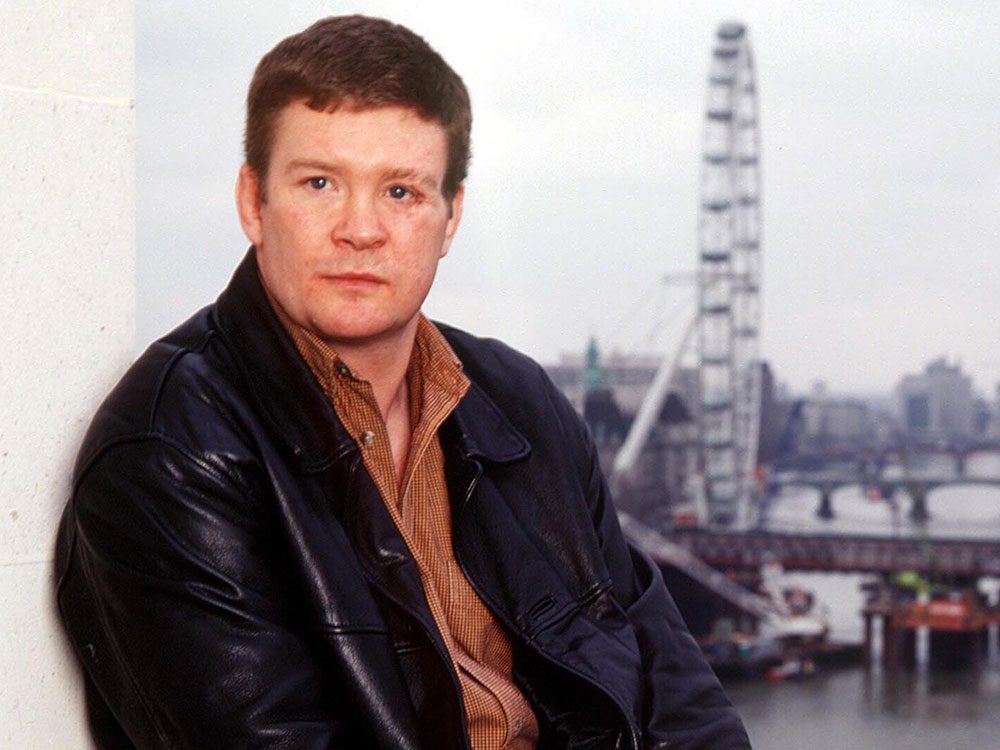
The tale of Trevor Rees-Jones
Half past midnight on August 31, 1997, a black Mercedes crashed into a concrete pillar outside the Pont de l’Alma tunnel in Paris. The world mourned the loss of Princess Diana in the wake of the crash, but she wasn’t the only victim. Driver Henri Paul and Diana’s boyfriend, Dodi Fayed, also lost their lives that night. Only one passenger came out alive: Trevor Rees-Jones, Fayed’s bodyguard.
In the front passenger seat of the car, Rees (who later dropped Jones from his name) had the protection of an airbag, though like the other passengers, he wasn’t wearing a seatbelt. Still, he didn’t come out unscathed. His face was crushed beyond recognition, the bones turned to powder. It took 150 pieces of titanium to reconstruct his face, and he was put into a coma for 10 days as doctors worked on that surgery, plus a broken wrist and chest injuries. It was a miracle he survived. (Don’t miss these powerful photos of Kensington Palace after Princess Diana’s death.)
In the wake of the crash, rumours and conspiracy theories began to emerge about why the accident happened and whether it could have been prevented—and Rees wasn’t immune from the finger-pointing. Critics argued he shouldn’t have let a supposedly visibly drunk Paul drive; he should have insisted Diana and Fayed wear seatbelts; he should have told Paul to slow down. Rees himself had little recollection of the fateful night’s events, the head trauma having caused amnesia. Meanwhile, Fayed’s father insisted Rees was lying about memory loss to avoid blame.
Given the strain with Fayed’s father after the crash, Rees quit his job with the family the year after the accident. He moved back to Shropshire county with his mom and stepfather, working at a friend’s sportswear store.
At first, Rees kept the few memories he had of the tragedy to himself. To this day, he’s given few interviews, though he did publish a book in 2000, The Bodyguard’s Story: Diana, the Crash, and the Sole Survivor, putting his side on the record once and for all. One of his few recollections of that night was a woman’s voice (presumably Diana’s) moaning “Dodi,” though he couldn’t say for sure if it was a real or false memory. Most of the reported £1 million ($1.5 million) he made from the book deal went toward legal fees for lawsuits led by Fayed’s dad. In the 2008 inquest of Diana’s death, though, it was concluded that Paul’s drunk driving and speeding—not actions by Rees, who police said was telling the truth—were to blame for the accident.
Rees later worked in Iraq, where he was living during the inquest, but he and his wife reportedly moved back to Shropshire, where he found work as a security consultant and played rugby with a local team. It was a return to a quiet life—just the way he wanted it.
Next, find out how Diana spent the final weeks of her life.
June 1997: Princess Diana glows with happiness
On June 3, 1997, Princess Diana attended a performance of Swan Lake by the English National Ballet, which was the only non-humanitarian charity to which Diana devoted her time, according to Good Housekeeping. Diana had always been a great lover of the ballet, and as a child had wished to take that very stage. Later in June, Diana walked hand-in-hand with Mother Teresa through the streets of the Bronx in New York, and on June 30, the July 1997 edition of Vanity Fair came out with Diana looking relaxed and gorgeous on the cover. (Discover more little-known facts about Princess Diana.)
July 1997: A month of ups and downs
July began delightfully for Princess Diana, starting with her 36th birthday, which she celebrated by attending a party at the Tate Gallery, where she was serenaded by Prince Harry and a group of his classmates singing “Happy Birthday.” But later that month saw the end of Diana’s relationship with Pakistani surgeon and cardiologist, Hasnat Khan, who Diana had wanted to marry, according to People. That same month, Diana’s former husband, Prince Charles, threw a lavish party for Camilla Parker Bowles, with whom he was now openly engaged in a romantic relationship. (Find out what really happened between Prince Charles and Princess Diana.)
In an effort to cheer herself up, Diana accepted the invitation of billionaire department store-owner, Mohamed Al-Fayed, to join his family for a beach vacation in Saint Tropez. It was there that Diana became romantically involved with Al-Fayed’s son, Dodi, whom she had met for the first time a decade earlier.
August 1997: A new romance for Princess Diana and continued devotion to charity
“Leaving behind speculation about a new romance, Princess Diana…took her crusade against land mines to Bosnia,” CNN reported on Aug. 8, 1997. Later in the month, Diana returned to the South of France in August to spend more time with Dodi, this time without her sons. It was during this holiday that she was captured kissing Dodi in a photograph that made headlines worldwide. Some believe the photograph had been staged to make Khan jealous.
Aug. 30, 1997: The wheels are unwittingly set in motion
On Aug. 30, Diana and Dodi flew to Paris where they spent time at the Ritz (owned by Dodi’s father) and tried to eat dinner at two different restaurants before the incessant hounding of paparazzi sent the pair in search of refuge.
Aug. 31, 1997: The final hours
At 12:20 a.m. (Paris time), Diana and Dodi leave the Ritz via its rear entrance and enter a black Mercedes S280 driven by Ritz security employee Henri Paul. The car speeds away from the hotel, but within minutes, at 12:23 a.m., collides with a concrete pillar in the Pont de l’Alma tunnel.
Dodi is killed instantly, as is Paul. Diana is extracted from the car using an electric chainsaw and rushed to Pitié-Salpétrière Hospital. During the drive to the hospital, her heart stops, but she’s revived using CPR and a defibrillator. At the hospital, Diana undergoes surgery but is pronounced dead at 4:00 a.m.
The only survivor of the car crash is Trevor Rees-Jones, the man appointed as Diana and Dodi’s bodyguard for the drive; he was the only one wearing a seat belt. It was later determined that Paul’s blood alcohol level was more than three times France’s legal limit.
Next, take a look back at 30 rarely seen photos of Princess Diana.
My husband, Larry, and I recently spent our spring vacation in Alberta. While the charming town of Banff is a must-see, exploring beyond Banff, either by car or on foot, is absolutely spectacular.
Larry and I set out with our GPS-equipped rental car to spend two days covering a veritable cornucopia of vistas and hikes, all within a relatively short distance.

Day One
On the first day of our Banff road trip, we drove the Minnewanka Loop area northeast of the Town of Banff. A mere 24 kilometres in length round trip, this scenic circular route passes a trio of pretty lakes with imposing views of several mountain ranges. The entire route can be covered in about an hour, but stopping en route to enjoy the scenery is a must.
Our first stop was Lower Bankhead where, along an overgrown, self-guided trail, we explored the ruins of an abandoned coal mining town. It was constructed by the C.P.R. and operated from 1904 to 1922 before shutting down. You can still see the coal slag heaps left behind.
Lake Minnewanka, which means the “lake of spirits” was indeed worth checking out. In fact, standing on the huge rocks of the stony beach set against the jagged, mountainous backdrop proved popular for taking “selfies.”

An even more rugged adventure was hiking the Stewart Canyon Trail along the lake’s north shore. The forest trail led to a bridge above the Cascade River. We climbed over boulders to reach the bottom of the steep canyon and the river’s edge. Afterwards, we continued driving to nearby Two Jack Lake where we devoured a well-earned picnic lunch.
As they say, we saved the best for last—Johnson Lake. We hiked around this placid lake and finally just sat on a shaded bench, admiring yet another stunning mountain panorama and watching the flurry of birds in their natural habitat. Thankfully, very few people had the same idea. Although it started to rain, we’d had a full day.
Discover more great bird-watching spots across Canada.

Day Two
Our second Banff day trip proved more challenging. We drove the scenic Bow Valley Parkway that runs parallel to the Trans-Canada Highway from Banff to Lake Louise along the meandering Bow River. We only covered half of it, saving legendary Lake Louise for another day. Driving at a reduced speed was mandatory due to the wildlife along the route and, sure enough, bighorn sheep and elk were grazing nonchalantly, unaware of the traffic stopping for photo ops.
After passing the Muleshoe Wetlands, we headed to our destination, Johnston Canyon. This gorge has been carved into the limestone bedrock by thousands of years of water erosion. Along with many tourists, we climbed narrow, railed walkways to view the impressive lower and upper waterfalls—spray included—surrounded by ancient worn rock and fallen, lichen-covered trees.
We spotted signs for the famous Ink Pots, and people who were returning said they were amazing, so we kept walking. The trail was mainly a long, strenuous uphill climb, but the sweeping views were equally breathtaking during our frequent rests. Everyone we passed kept saying it wasn’t too far! We finally reached an alpine meadow, surrounded by snow-capped mountains. The unique Ink Pots were indeed colourful—five blue-green mineral springs that bubbled up from deep below the mountains. We rested on benches, meeting fellow travellers who shared their snacks with us as we’d come unprepared.
Thankfully, the return trek was mostly downhill. In total, we’d hiked 12 kilometres! Johnston Canyon tested our endurance levels, but we conquered it.
We later enjoyed a late lunch overlooking a winding river alongside railway tracks and, as if on cue, a train rumbled by. To top off the day, we drove to Castle Cliffs viewpoint, where you can see the profile of Castle Mountain, named for its castellated, fortress-like appearance—no further hiking was involved!
Although we returned to Banff via the highway as it was quicker, the scenic route is definitely etched in my memory forever.
Now that you’ve got inspiration for your own Banff day trip, find out why Banff’s Tunnel Mountain doesn’t actually have a tunnel.
You may know the silent signs of a heart attack or stroke, but preventing one is another beast altogether. Exercise and sleep are great habits that reduce your risk, but don’t overlook the power of your diet. According to a study, you might want to add bananas and other potassium-rich foods to your plan.
Researchers at the University of Alabama have found that eating bananas every day could help prevent heart attacks and strokes. Their study, which aimed to determine how the mineral potassium affects blood flow and artery health, examined mice who received a diet containing either low, normal, or high levels of potassium. Overall, mice given a low-potassium diet had much harder arteries than their counterparts. Mice who received high levels of potassium, on the other hand, showed significantly less artery hardening and reduced stiffness in their aorta, as well.
Previous research supports the importance of potassium
Previous studies and data also show that a potassium-rich diet helps lower blood pressure and reduce the risk of heart disease, according to Ragavendra Baliga, MD, a cardiologist at the Ohio State University Wexner Medical Center. “One analysis published in the Journal of American College of Cardiology in 2011 included data from 11 studies and 250,000 people,” Dr. Baliga says. “This study reported that an average increase of 1540 mg of dietary potassium per day is linked to a 21 per cent reduced risk of stroke.”
The University of Alabama study, however, is among the first to investigate the mineral’s impact on artery health. Getting enough potassium helps maintain a healthy heartbeat, according to Michelle Routhenstein, MS, RD, CDN, CDE, a preventative cardiology dietitian. “When potassium is deficient, low levels can cause heart arrhythmias and potentially impair blood flow to the brain, muscles, and organs,” she says. According to experts, potassium also improves your heart’s function by regulating your heartbeat, digesting carbohydrates, and building muscle. The combination of these perks could do wonders for your arteries, preventing heart disease and strokes down the road.
More research is necessary—and bananas aren’t the only way to eat potassium
The results of the study are promising, according to Ali Webster, RD, PhD, the associate director at the International Food Information Council. However, researchers need to replicate this in people to draw a definitive conclusion. “It certainly won’t hurt to eat potassium-rich foods every day, unless you’ve been instructed to watch your intake,” Webster says. “But we can’t say that one specific food is going to prevent cardiovascular disease.” You need to consider the whole diet as well as other risk factors, too, Routhenstein adds.
For most people, eating potassium-rich foods like bananas, sweet potatoes, beans, and dark leafy greens will contribute to a healthy diet and possibly reduce the risk for cardiovascular disease, according to Webster. Many people in North America consume less potassium than is recommended, and the Dietary Guidelines for Americans named potassium a “nutrient of public health concern.”
While bananas have a reputation for containing lots of potassium, Dr. Baliga normally recommends broccoli, spinach, carrots, cauliflower, and other vegetables to his patients instead. So don’t worry if you hate the yellow fruit—there are still plenty of ways to meet the recommended daily intake of potassium!
Next, find out how it’s actually possible to reverse heart disease.
In the summer, you’re more likely than ever to carry a water bottle around in your car. After all, opening the door of a stiflingly hot vehicle makes you want to chug some water pronto.
Sure, a water bottle that’s been sitting in the sun all day isn’t the most refreshing thirst-quencher in the summer heat. But there’s a more dangerous reason not to leave one on the seat: It could start a fire.
Seems backwards that water could cause a fire, but the secret is in the round bottle shape. On a hot day, the sun shines through the window and through the full water bottle. Like a magnifying glass, the water inside concentrates the light—and its heat—to one spot. The point on the seat where the rays are focused can get hot enough to create flames.
And we’re not just talking hypotheticals here. In a Facebook video from Idaho Power, station battery technician Dioni Amuchastegui says it happened to him.
Amuchastegui was sitting in his parked car eating lunch when he noticed smoke inside. Taking a closer look, he realized the spot of light under his water bottle was starting to catch fire. “I had to do a double take,” says Amuchastegui. “It was hot enough to start burning a hole through the seat.” Sure enough, the extreme heat left two little burn marks. Thankfully, he noticed it before it could do any major damage. (Here’s how to fix burn holes in your car’s upholstery.)
To avoid the scary fire risk, carry your bottle with you instead of leaving it in an overheating car. If you absolutely must keep it inside, stash it under a seat so it’s out of the sun.
Next, discover 15 more things you should never leave in the car.
Cardiovascular diseases affect the circulatory system including the heart and blood vessels. According to Heart and Stroke, nine in 10 Canadians have at least one of the risk factors for heart disease and stroke. The good news is that both heart disease and stroke are considered preventable, and many of the contributing factors are within your control. Showing your heart some love can significantly reduce your risk—and help you stay healthier in the long run.
Risk Factors for Heart Disease
Age
Men over 45 and women over 55 are at higher risk of heart disease.
Gender
Men are at higher risk of heart disease than women, although the risk for women rises after menopause.
Family history
If any immediate family members (parents, siblings) have had high blood pressure, high cholesterol or a heart attack, your risk of heart disease is higher. (Learn to spot the heart attack symptoms that are frequently misdiagnosed.)
High blood pressure
One in four Canadians has high blood pressure (hypertension), which raises the risk of both heart disease and stroke. A nutritious diet, healthy body weight and regular exercise can help lower your blood pressure. Medication can also help—talk to your doctor or pharmacist.
High cholesterol
“Bad” LDL cholesterol causes hardening of the arteries (atherosclerosis), increasing your risk of cardiovascular disease. As with high blood pressure, achieving a healthy weight, exercising more or taking medication can help lower your cholesterol.

Being overweight
Excessive body weight raises your risk for heart disease and other health problems. Knowing your Body Mass Index (BMI) can help you determine if you are at a healthy weight.
Lack of exercise
Ready to get moving? Regular physical activity can help prevent heart disease, help you lose weight, decrease stress and more. Mix it up! Join a gym, take dance lessons, try a team sport or start a lunchtime walking club with your co-workers. Be sure to speak with your physician before starting an exercise program.
Unhealthy diet
Eating more fruits and vegetables, and cutting back on sodium, saturated fats and trans fats, are great heart-healthy steps. To learn more about good nutrition and portion sizes, consult Canada’s Food Guide. Try planning each week’s meals in advance so that you’ll have nutritious options ready when things get hectic—plus you’ll spend less on packaged, processed and fast foods.
Smoking
Here’s a great reason to butt out: according to Heart & Stroke, your risk of heart disease and stroke starts to decrease as soon as you quit. Within a year, your chances of dying from smoking-related heart disease is reduced by half. For free resources to help you quit, visit Smokers’ Helpline.
Excessive alcohol intake
Drinking too much can raise your blood pressure, which in turn increases your risk of heart disease and stroke. Men should have no more than three drinks per day most days (maximum 15 per week), and women should not have more than two drinks per day most days (maximum 10 per week). For more on safer alcohol consumption, see Canada’s Low-Risk Alcohol Drinking Guidelines.
It takes time to change habits, so start small and keep building positive, cardio-friendly habits into your daily routine. Over time, you’ll notice the benefits—and your heart will thank you.
Now that you know the risk factors for heart disease, find out how you can actually reverse heart disease.
